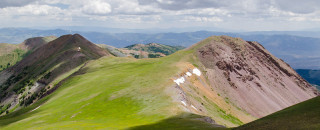Explorer Corps Marker: Beaver County
Find the Marker
The Beaver County Explorer Corps marker is located at the Minersville Campground on the Minersville Reservoir. The campground is approximately 11 miles west of Beaver on UT-21.
GPS 38°13’4.044”N 112°49’37.38”W
Dig Deeper

Mountains are really interesting places to study the natural world. Tall mountains may have significantly different ecosystems at their base and their summit, providing homes for different species of plants and animals. And for Utah zoologists, the Tushar Mountains of Beaver County are a fantastic place to see how geography and topography intersect to create unique ecosystems.
The Tushar Mountains are the third highest mountain range in Utah. (The Uinta Mountains and the La Sal Mountains are the only ranges that are higher.) And these mountains are tall. The Tushar Range’s Mount Belknap tops 12,137 feet while the nearby Mount Baldy comes in at a still-impressive 12,090 feet. The name Tushar is thought to be a modification of the word “t’shar”, meaning “white” in the language of the Southern Paiute.
Forests cover much of the Tushar Mountains, ecosystems at the base of the mountain shading into sub-alpine and alpine habitats with the climb. Douglas fir, aspen, Engelmann spruce, and pines dot the mountainsides, not to mention mountain meadows and forests of pinion pine and juniper. What’s more, the Tushars are located along the southeastern margin of the Great Bain, close to the western edge of the Colorado Plateau. That means that animals and plants found in both the Great Basin and on the Colorado Plateau often live side-by-side on these mountains, a mix of two of the Southwest’s great ecological regions.
The unusual nature of the Tushar Mountains has been drawing the attention of zoologists for decades. In the 1960s, mammologist Guy G. Musser made collections of the mammals found in the Tushar Mountains and nearby Pavant Range. NHMU zoologists later carried out a comparable project to follow-up on Musser’s work and see what had changed in the intervening years.
In recent years, the Tushars have become well-known for a particular mammal – wild mountain goats. These white, shaggy beasts are only found in one place in southwestern Utah, and that’s in the Tushars. To have a chance at seeing them, though, you have to go high. Mountain goats live high up, where the alpine forests give way to rocky slopes and ridgelines along the mountains. The Utah Division of Wildlife Resources even holds a Goat Watch in August, if you could use a little help spotting the white fluffballs as they clop along the mountaintops.
Want to Go Farther?
The Tushar Mountains are about 30 miles northeast of the Campground. Hike the Birch Lake Trail or other pathways in the Tushars.
